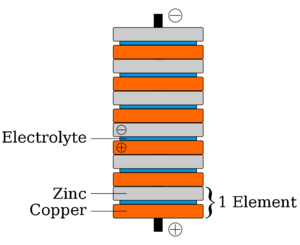Voltaic Pile: Difference between revisions
No edit summary |
No edit summary |
||
| (11 intermediate revisions by 2 users not shown) | |||
| Line 1: | Line 1: | ||
[[Image:Voltaic pile.png|thumb|right|A copper-zinc voltaic pile.]] | |||
[[ | The Italian inventor [[Alessandro Volta|Alessandro Volta invented]] the first battery in 1799. Volta’s battery was called a “pile” and was a stack (or pile) of discs made of two types of metal—one silver, the other zinc. The discs were separated from each other by a piece of cloth or cardboard that had been soaked in salt water. Volta found that this wet stack of “dissimilar metals” created a small electric current, and this current could be drawn off through wires and used for experiments. However, a pile could generate only a small voltage of 1-2 volts. Several piles—a “battery” of them—could be assembled side by side and connected to each other with metal strips to create a high power energy source. Volta gave his name to units of electrical energy, the “volt.” | ||
== Further Reading == | |||
[[Milestones:Volta's Electrical Battery Invention, 1799|Volta's Electrical Battery Invention, 1799]] - Recognized as an IEEE Milestone | |||
[[Category: | [[Category:Energy]] | ||
[[Category:Electrochemical_devices_ | [[Category:Electrochemical_devices_&_processes]] | ||
[[Category:Batteries]] | [[Category:Batteries]] | ||
[[Category:Materials]] | |||
[[Category:Metals]] | |||
[[Category:Zinc]] | |||
Latest revision as of 19:55, 28 September 2015
The Italian inventor Alessandro Volta invented the first battery in 1799. Volta’s battery was called a “pile” and was a stack (or pile) of discs made of two types of metal—one silver, the other zinc. The discs were separated from each other by a piece of cloth or cardboard that had been soaked in salt water. Volta found that this wet stack of “dissimilar metals” created a small electric current, and this current could be drawn off through wires and used for experiments. However, a pile could generate only a small voltage of 1-2 volts. Several piles—a “battery” of them—could be assembled side by side and connected to each other with metal strips to create a high power energy source. Volta gave his name to units of electrical energy, the “volt.”
Further Reading
Volta's Electrical Battery Invention, 1799 - Recognized as an IEEE Milestone
